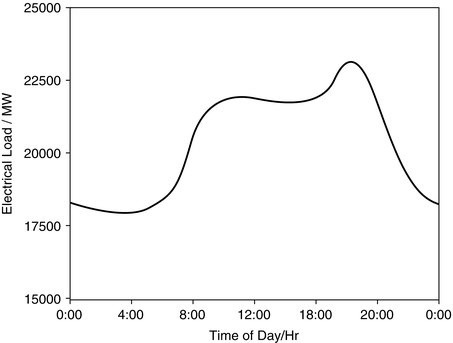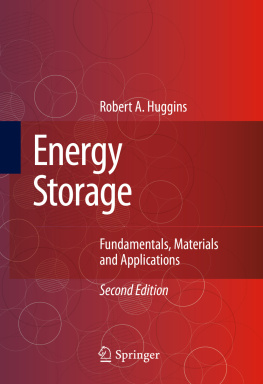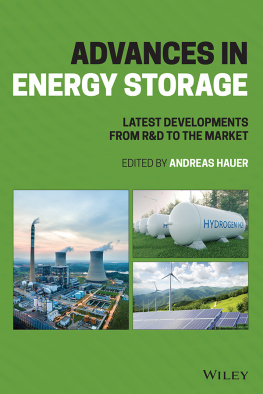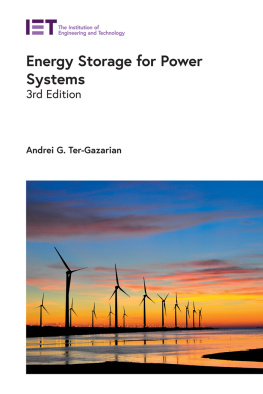1.1 Introduction
Concern about the inevitable depletion of the fossil fuels that are now the major sources of energy has been greatly reduced, due to the recent development of fracking technology, as described in the Preface, and which will be further discussed in Chap.. However, there is another matter that is very important in considering the effective use of the energy that is available. This involves the relationships between the several types of energy, and also the various different uses of energy.
Worldwide energy consumption is between 500 and 600 EJ (561020 J). In terms of consumption rate this is 1518 TW (1.51.81013 W). The USA consumes about 25 % of the total, although its share of the worlds population is only about 5 %.
A recent estimate of the major US sources of energy is shown in Table .
Table 1.1
Major sources of energy used in the USA in 2007 []
Source | Percent of total |
|---|
Petroleum | 39.4 |
Natural gas | 23.3 |
Coal | 22.5 |
Renewable energies | 6.6 |
Nuclear electric | 8.2 |
Total | |
Table 1.2
Major uses of energy []
Type of use | Percent of total energy use |
|---|
Transportation | 28.6 |
Industrial | 21.1 |
Residential, commercial buildings | 10.3 |
Electric power | 40.0 |
Total | |
These different types of applications have different requirements for access to energy, and different characteristics of its use. One of the important problems with the effective use of available energy supplies is that the schedule of energy use is often not synchronous with its acquisition, even from natural sources. Thus buffer, or storage, systems are necessary.
This requirement for storage mechanisms is highly dependent upon the type of use. Those that consume fossil fuels, or their derivatives, for combustion purposes, such as for space heating or internal combustion-powered automobiles, require one type of storage and distribution system. Another, quite different, category involves the various applications that acquire their energy from the large-scale electric power transmission and distribution (T&D) grid. In that case, there are two types of storage systems to consider. One involves the electric power grid system itself, and the time dependence of its energy supplies and demands, and the other has to do with storage mechanisms applicable to the various systems and devices that acquire their energy from the grid.
There are mechanisms whereby one type of source or storage technology is converted another. One example is the use of pumped-hydro storage to both take electricity and return electricity to the grid, as will be described later. Pumped-hydro technology actually operates by a mechanical storage mechanism, as it is based upon the gravitational difference between two different water storage reservoirs. Another is the use of flywheels to reversibly convert mechanical energy into electrical energy.
It will be seen that there are many different types of energy storage methods and technologies. Some of the largest of these are owned and/or operated by energy suppliers. Smaller ones are primarily related to energy users.
1.2 Storage in the Fuel Distribution System
In the simplest case, natural fuels such as wood, coal, or crude oil can be stored locally or within the transportation system, in piles, tanks, ships, and pipelines. For example, crude oil and some of the lighter petrochemical products are stored in tanks in oil depots (sometimes called oil terminal tank farms) in the vicinity of the refineries. These are often near marine tanker harbors or pipelines. This type of transient buffer storage generally has a relatively small capacity, however, and must be supplemented by other methods that can handle much larger amounts of energy.
1.3 Periodic Storage
A number of energy sources do not provide energy at a constant rate, but instead, are intermittent. Sometimes, they have a good measure of periodicity. As an example, some of the biofuels, such as switch grass, sugar cane, corn, and oilseeds are only available during part of the year. Likewise, solar, wind, and ocean motion energy sources have roughly daily cycles.
The time dependence of the uses of energy often does not correspond to the time variance of such sources. If these were to match perfectly, there would be no need for a storage mechanism. Perfect time-matching is not likely, however. Instead, at least part of the energy is supplied into some type of storage mechanism, from which it is (later) extracted when it is needed.
What is preferable is a situation in which the combination of current energy production and stored energy match the energy and power requirements at all times. This is sometimes called load management, but it should actually be called resource management. Overcapacity in either energy sources or storage systems is expensive, and a great deal of attention is given to how to most effectively and inexpensively meet the needs of energy users.
1.3.1 Long-Term, or Seasonal, Storage
Although there are exceptions, such as the local storage of wood mentioned in the Preface, seasonal storage generally involves very large installations, such as reservoirs and dams that accumulate water primarily during the rainy (or snowy) season of the year. Electric power is produced in hydroelectric facilities by passing water through large turbines. The water collected in such facilities is often used for agricultural purposes, as well as for energy production. Agricultural needs also vary with time during the year.
1.3.2 Daily and Weekly Storage
A number of energy sources produce energy on a daily cycle, related to the periodic characteristics of the sun, tides, and sometimes, wind. It is thus necessary to have mechanisms whereby this energy can be available when needed, and temporarily stored when not needed. But energy from these sources can also vary with the time of the year, and can be significantly affected by changes in the weather, on both long and short time scales. It is common for these sources to be connected to the large electrical transmission grid, providing energy to it when they are in operation. Thus the grid also acts as a buffer and storage medium.
1.4 The Problem of Load Leveling
The electrical load varies significantly with both the location and the time of day. An example is shown in Fig.. The major components, industrial, commercial and residential, require energy at different times during the day. For example, residential use includes lighting, space heating and air conditioning, and often electric water heaters and cooking appliances.













